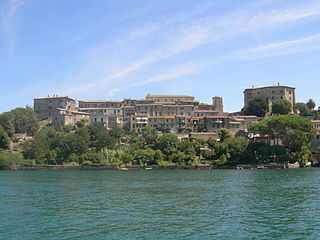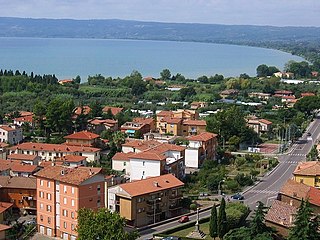Nortia is the Latinized name of the Etruscan goddess Nurtia, whose sphere of influence was time, fate, destiny, and chance.
In Etruscan mythology, Voltumna or Veltha was the chthonic deity, who became the supreme god of the Etruscan pantheon, the deus Etruriae princeps, according to Varro. Voltumna's cult was centered in Volsini a polis of the Etruscan Civilization of central Italy.
Italy is a volcanically active country, containing the only active volcanoes in mainland Europe. The country's volcanism is due chiefly to the presence, a short distance to the south, of the boundary between the Eurasian Plate and the African Plate. The magma erupted by Italy's volcanoes is thought to result from the subduction and melting of one plate below another.

The Corporal of Bolsena dates from a Eucharistic miracle in Bolsena, Italy, in 1263 when a consecrated host allegedly began to bleed onto a corporal, the small cloth upon which the host and chalice rest during the Canon of the Mass. The appearance of blood was seen as a miracle to affirm the Roman Catholic doctrine of transubstantiation, which states that the bread and wine become the Body and Blood of Christ at the moment of consecration during the Mass. Today the Corporal of Bolsena is preserved in a rich reliquary at Orvieto in the cathedral. The reddish spots on the cloth, upon close observation, show the profile of a face similar to those that traditionally represent Jesus Christ. It is said that the miraculous bleeding of the host occurred in the hands of an officiating priest who had doubts about transubstantiation. The "Miracle of Bolsena" is regarded by the Roman Catholic Church as a private revelation, meaning that Catholics are under no obligation to believe it although they may do so freely.

Lake Bolsena of central Italy, is a lake of volcanic and tectonic origin. Roman historic records indicate activity of the Vulsini volcano occurred as recently as 104 BC; it has been dormant since then. The two islands in the southern part of the lake were formed by underwater eruptions following the collapse that created the depression.

Montefiascone is a town and comune of the province of Viterbo, in Lazio, central Italy. It stands on a hill on the southeast side of Lake Bolsena, about 100 km (60 mi) north of Rome.

San Lorenzo Nuovo is a small town and comune in the province of Viterbo, in the Latium region of Italy. It is an agricultural center producing potatoes, olive oil, garlic, onions, cereals and grapes. A second source of revenue is tourism.

Capodimonte is a comune (municipality) in the Province of Viterbo in the Italian region Lazio, located about 90 kilometres (56 mi) northwest of Rome and about 20 kilometres (12 mi) northwest of Viterbo. It is on the southwestern shore of Lake Bolsena. In contrast to the other communities on the lake, Capodimonte has a headland with a sheltered harbor.

Gradoli is a comune (municipality) in the Province of Viterbo in the Italian region Latium, located about 100 kilometres (62 mi) northwest of Rome and about 35 kilometres (22 mi) northwest of Viterbo.

The Mass at Bolsena is a painting by the Italian renaissance artist Raphael. It was painted between 1512 and 1514 as part of Raphael's commission to decorate with frescoes the rooms that are now known as the Raphael Rooms, in the Apostolic Palace in the Vatican. It is located in the Stanza di Eliodoro, which is named after The Expulsion of Heliodorus from the Temple.
The Fanum Voltumnae was the chief sanctuary of the Etruscans; fanum means a sacred place, a much broader notion than a single temple. Numerous sources refer to a league of the “Twelve Peoples” (lucumonies) of Etruria, formed for religious purposes but evidently having some political functions. The Etruscan league of twelve city-states met annually at the Fanum, located in a place chosen as omphalos, the geographical and spiritual centre of the whole Etruscan nation. Each spring political and religious leaders from the cities would meet to discuss military campaigns and civic affairs and pray to their common gods. Chief amongst these was Voltumna, possibly state god of the Etruria.
Like the Egyptians, Phoenicians and Carthaginians, the Etruscans were rather slow to adopt the invention of coinage. The brief period of Etruscan coinage, with the predominance of marks of value, seems to be an amalgam that reconciles two very different monetary systems: the ‘primitive’ bronze-weighing and aes grave economy of central Italy with that of struck silver and gold issues of southern Italian Greek type not familiar in Etruria.

Vulsini, also known as Volsini volcano, Vulsini Volcanic District, Vulsini Volcanic Complex and the Vulsinian District, is a circular region of intrusive igneous rock in Lazio, Italy, about 87 km (54 mi) to the north northwest of Rome, containing a cluster of calderas known to have been active in recent geologic and historical times. Potentially they still are active. The Vulsinian region is one of dozens of intrusive circular regions, most smaller than the Vulsinian, arranged in a band from Campania through Lazio, called the Roman Comagmatic Province. A comagmatic province is a geologic area of the same type and age igneous rock deriving from the same crustal magma. The Roman region is post-collisional; that is, the intrusions were not a result of the lateral stresses that created Italy and raised the Apennines, but were subsequent to Italy's creation. The Volsinian is the northernmost region.
Bolsena can refer to the following items:

Saint Christina of Bolsena, also known as Christina of Tyre, or in the Eastern Orthodox Church as Christina the Great Martyr, is venerated as a Christian martyr of the 3rd century. Archaeological excavations of an underground cemetery constructed at her tomb have shown that she was venerated at Bolsena by the fourth century.

Bolsena Lacus is one of a number of hydrocarbon lakes found on Saturn's largest moon, Titan.
In ancient Italy, the Etruscan "Lega dei popoli" was a league comprising several towns — usually, but not necessarily, twelve — located in the areas that today are known as Tuscany, western Umbria and northern Lazio.












